Nursing Interventions for Women with Osteoporosis: A Review
VerifiedAdded on 2023/06/03
|36
|5697
|87
Literature Review
AI Summary
This literature review, conducted by a student at the University of Wollongong, explores nursing interventions for women with osteoporosis. The study investigates both educational and medical interventions, analyzing 15 relevant journal articles published between 2014 and 2018. Educational interventions focus on health education, emphasizing the importance of self-efficacy, nutrition, and exercise in managing the condition. Medical interventions include estrogen replacement therapy and the use of oral bisphosphonates. The review highlights the significance of these interventions in preventing fractures and improving the quality of life for women affected by osteoporosis. The search strategy utilized Medline, CINNAL, and Scopus databases, along with Google Scholar, to gather evidence. The review underscores the critical role of nurses in educating patients and implementing effective treatment strategies.
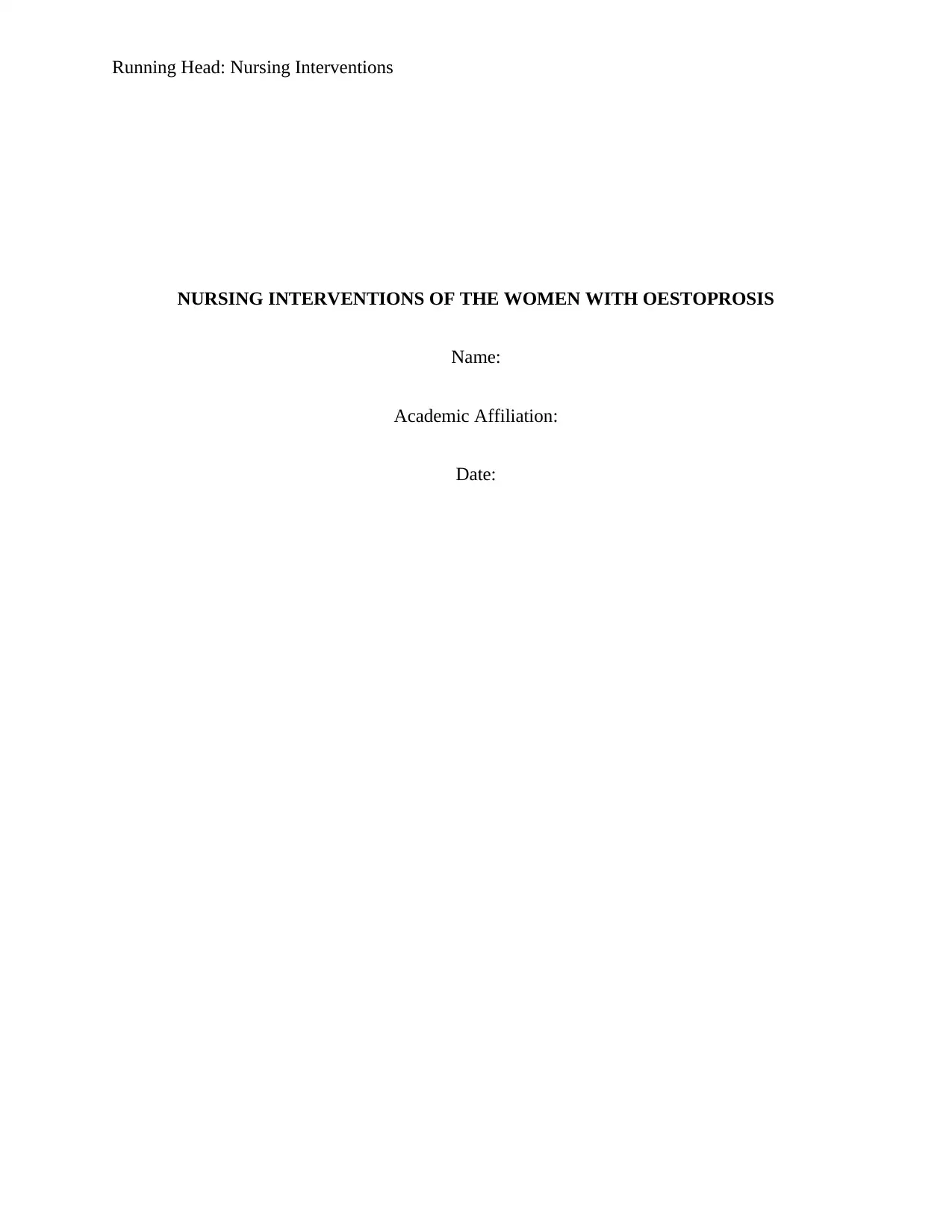
Running Head: Nursing Interventions
NURSING INTERVENTIONS OF THE WOMEN WITH OESTOPROSIS
Name:
Academic Affiliation:
Date:
NURSING INTERVENTIONS OF THE WOMEN WITH OESTOPROSIS
Name:
Academic Affiliation:
Date:
Paraphrase This Document
Need a fresh take? Get an instant paraphrase of this document with our AI Paraphraser
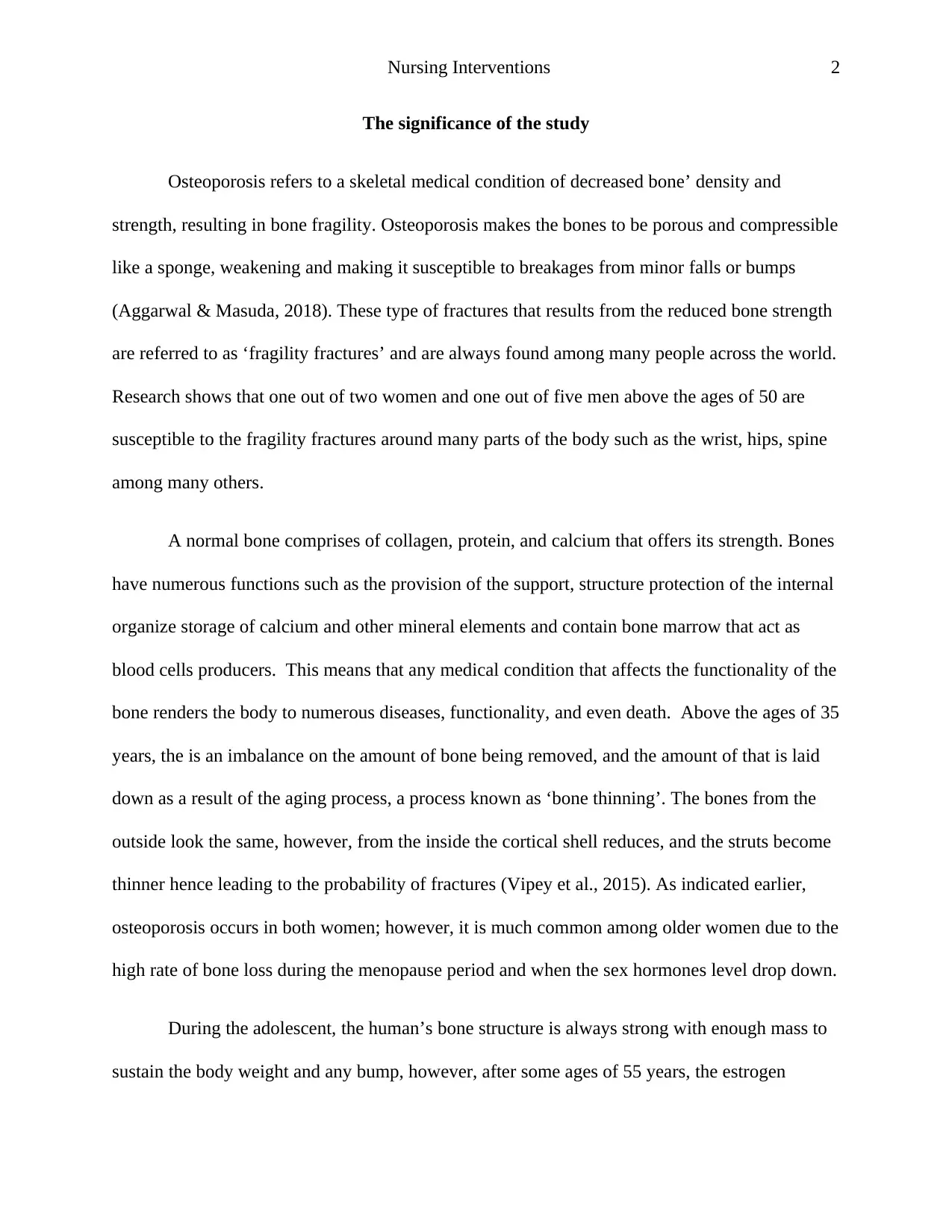
Nursing Interventions 2
The significance of the study
Osteoporosis refers to a skeletal medical condition of decreased bone’ density and
strength, resulting in bone fragility. Osteoporosis makes the bones to be porous and compressible
like a sponge, weakening and making it susceptible to breakages from minor falls or bumps
(Aggarwal & Masuda, 2018). These type of fractures that results from the reduced bone strength
are referred to as ‘fragility fractures’ and are always found among many people across the world.
Research shows that one out of two women and one out of five men above the ages of 50 are
susceptible to the fragility fractures around many parts of the body such as the wrist, hips, spine
among many others.
A normal bone comprises of collagen, protein, and calcium that offers its strength. Bones
have numerous functions such as the provision of the support, structure protection of the internal
organize storage of calcium and other mineral elements and contain bone marrow that act as
blood cells producers. This means that any medical condition that affects the functionality of the
bone renders the body to numerous diseases, functionality, and even death. Above the ages of 35
years, the is an imbalance on the amount of bone being removed, and the amount of that is laid
down as a result of the aging process, a process known as ‘bone thinning’. The bones from the
outside look the same, however, from the inside the cortical shell reduces, and the struts become
thinner hence leading to the probability of fractures (Vipey et al., 2015). As indicated earlier,
osteoporosis occurs in both women; however, it is much common among older women due to the
high rate of bone loss during the menopause period and when the sex hormones level drop down.
During the adolescent, the human’s bone structure is always strong with enough mass to
sustain the body weight and any bump, however, after some ages of 55 years, the estrogen
The significance of the study
Osteoporosis refers to a skeletal medical condition of decreased bone’ density and
strength, resulting in bone fragility. Osteoporosis makes the bones to be porous and compressible
like a sponge, weakening and making it susceptible to breakages from minor falls or bumps
(Aggarwal & Masuda, 2018). These type of fractures that results from the reduced bone strength
are referred to as ‘fragility fractures’ and are always found among many people across the world.
Research shows that one out of two women and one out of five men above the ages of 50 are
susceptible to the fragility fractures around many parts of the body such as the wrist, hips, spine
among many others.
A normal bone comprises of collagen, protein, and calcium that offers its strength. Bones
have numerous functions such as the provision of the support, structure protection of the internal
organize storage of calcium and other mineral elements and contain bone marrow that act as
blood cells producers. This means that any medical condition that affects the functionality of the
bone renders the body to numerous diseases, functionality, and even death. Above the ages of 35
years, the is an imbalance on the amount of bone being removed, and the amount of that is laid
down as a result of the aging process, a process known as ‘bone thinning’. The bones from the
outside look the same, however, from the inside the cortical shell reduces, and the struts become
thinner hence leading to the probability of fractures (Vipey et al., 2015). As indicated earlier,
osteoporosis occurs in both women; however, it is much common among older women due to the
high rate of bone loss during the menopause period and when the sex hormones level drop down.
During the adolescent, the human’s bone structure is always strong with enough mass to
sustain the body weight and any bump, however, after some ages of 55 years, the estrogen
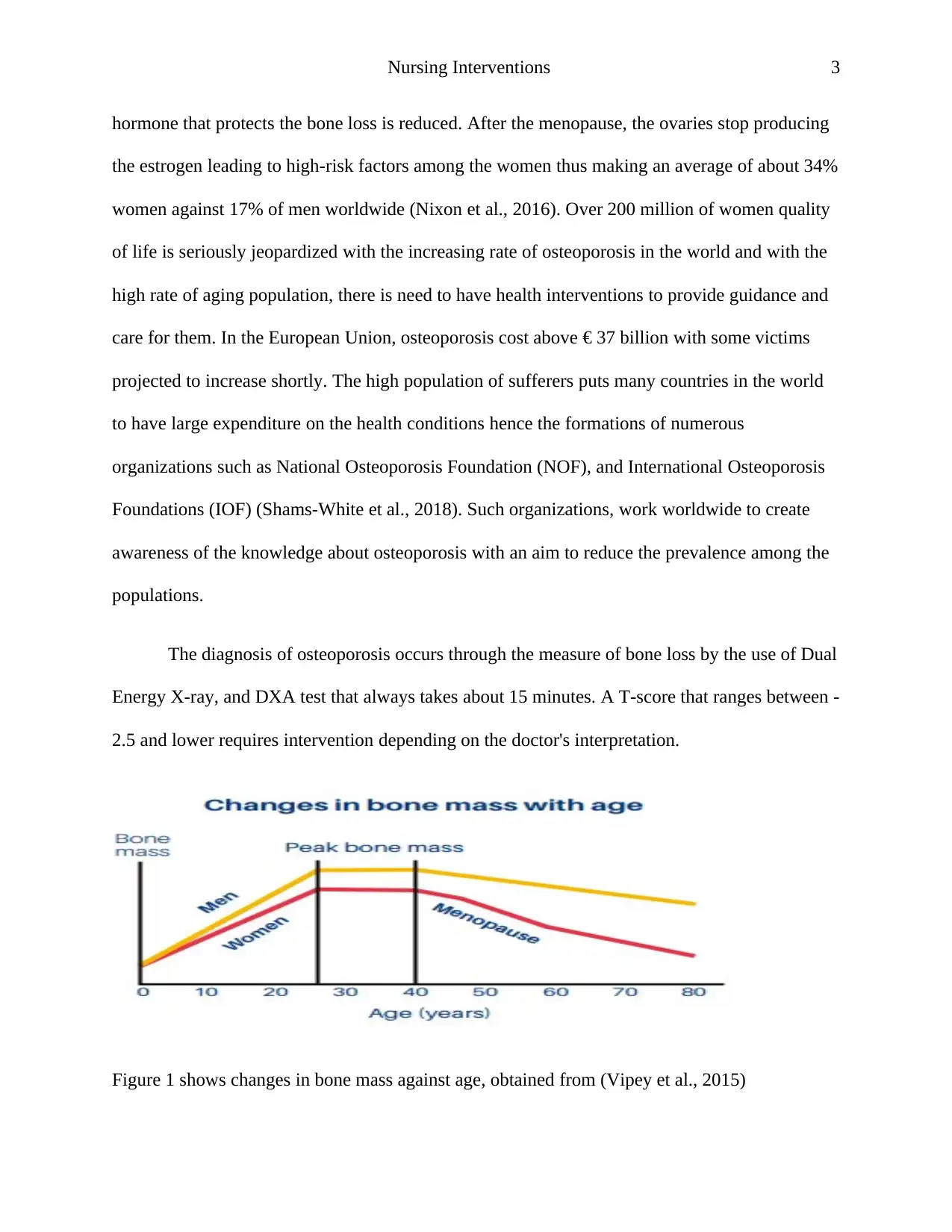
Nursing Interventions 3
hormone that protects the bone loss is reduced. After the menopause, the ovaries stop producing
the estrogen leading to high-risk factors among the women thus making an average of about 34%
women against 17% of men worldwide (Nixon et al., 2016). Over 200 million of women quality
of life is seriously jeopardized with the increasing rate of osteoporosis in the world and with the
high rate of aging population, there is need to have health interventions to provide guidance and
care for them. In the European Union, osteoporosis cost above € 37 billion with some victims
projected to increase shortly. The high population of sufferers puts many countries in the world
to have large expenditure on the health conditions hence the formations of numerous
organizations such as National Osteoporosis Foundation (NOF), and International Osteoporosis
Foundations (IOF) (Shams-White et al., 2018). Such organizations, work worldwide to create
awareness of the knowledge about osteoporosis with an aim to reduce the prevalence among the
populations.
The diagnosis of osteoporosis occurs through the measure of bone loss by the use of Dual
Energy X-ray, and DXA test that always takes about 15 minutes. A T-score that ranges between -
2.5 and lower requires intervention depending on the doctor's interpretation.
Figure 1 shows changes in bone mass against age, obtained from (Vipey et al., 2015)
hormone that protects the bone loss is reduced. After the menopause, the ovaries stop producing
the estrogen leading to high-risk factors among the women thus making an average of about 34%
women against 17% of men worldwide (Nixon et al., 2016). Over 200 million of women quality
of life is seriously jeopardized with the increasing rate of osteoporosis in the world and with the
high rate of aging population, there is need to have health interventions to provide guidance and
care for them. In the European Union, osteoporosis cost above € 37 billion with some victims
projected to increase shortly. The high population of sufferers puts many countries in the world
to have large expenditure on the health conditions hence the formations of numerous
organizations such as National Osteoporosis Foundation (NOF), and International Osteoporosis
Foundations (IOF) (Shams-White et al., 2018). Such organizations, work worldwide to create
awareness of the knowledge about osteoporosis with an aim to reduce the prevalence among the
populations.
The diagnosis of osteoporosis occurs through the measure of bone loss by the use of Dual
Energy X-ray, and DXA test that always takes about 15 minutes. A T-score that ranges between -
2.5 and lower requires intervention depending on the doctor's interpretation.
Figure 1 shows changes in bone mass against age, obtained from (Vipey et al., 2015)
⊘ This is a preview!⊘
Do you want full access?
Subscribe today to unlock all pages.

Trusted by 1+ million students worldwide
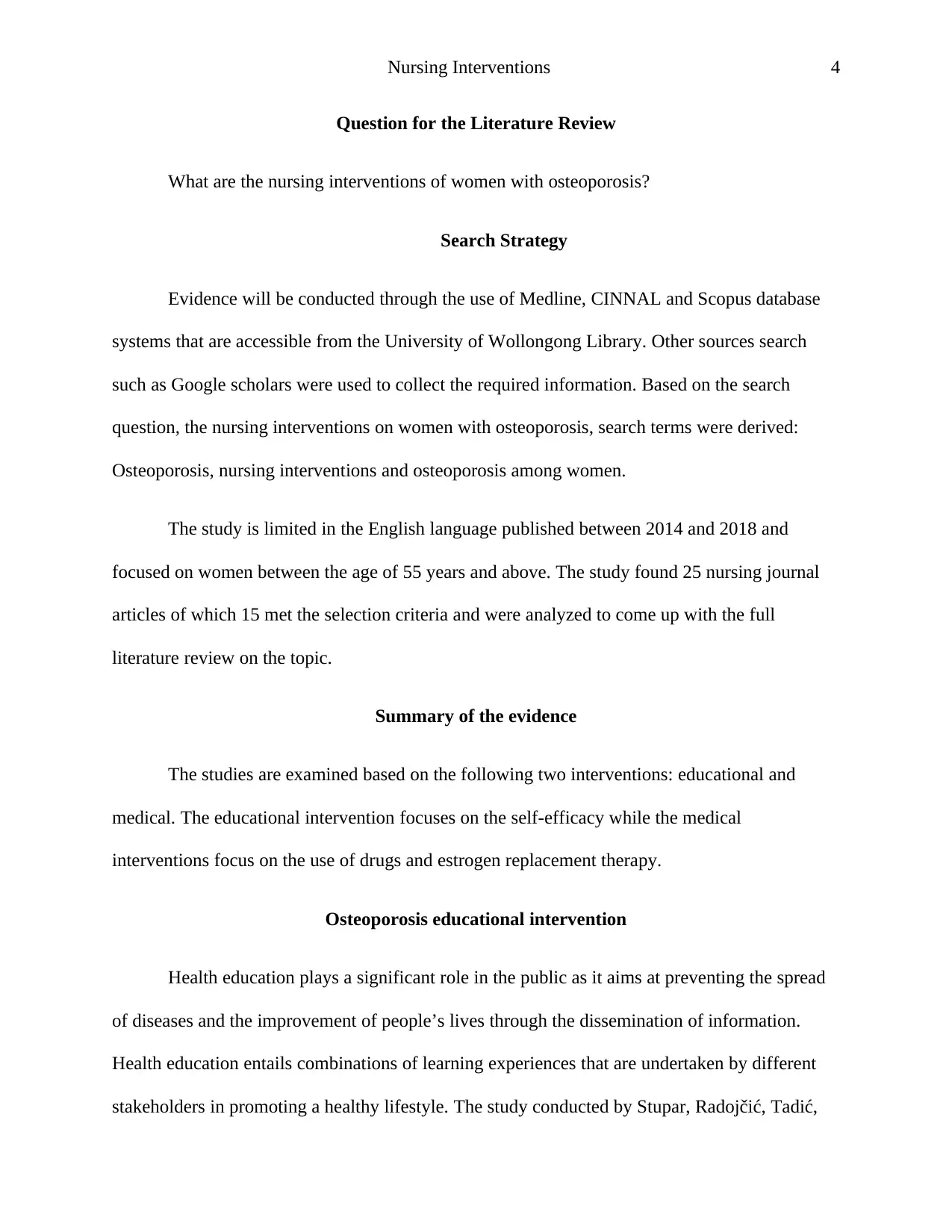
Nursing Interventions 4
Question for the Literature Review
What are the nursing interventions of women with osteoporosis?
Search Strategy
Evidence will be conducted through the use of Medline, CINNAL and Scopus database
systems that are accessible from the University of Wollongong Library. Other sources search
such as Google scholars were used to collect the required information. Based on the search
question, the nursing interventions on women with osteoporosis, search terms were derived:
Osteoporosis, nursing interventions and osteoporosis among women.
The study is limited in the English language published between 2014 and 2018 and
focused on women between the age of 55 years and above. The study found 25 nursing journal
articles of which 15 met the selection criteria and were analyzed to come up with the full
literature review on the topic.
Summary of the evidence
The studies are examined based on the following two interventions: educational and
medical. The educational intervention focuses on the self-efficacy while the medical
interventions focus on the use of drugs and estrogen replacement therapy.
Osteoporosis educational intervention
Health education plays a significant role in the public as it aims at preventing the spread
of diseases and the improvement of people’s lives through the dissemination of information.
Health education entails combinations of learning experiences that are undertaken by different
stakeholders in promoting a healthy lifestyle. The study conducted by Stupar, Radojčić, Tadić,
Question for the Literature Review
What are the nursing interventions of women with osteoporosis?
Search Strategy
Evidence will be conducted through the use of Medline, CINNAL and Scopus database
systems that are accessible from the University of Wollongong Library. Other sources search
such as Google scholars were used to collect the required information. Based on the search
question, the nursing interventions on women with osteoporosis, search terms were derived:
Osteoporosis, nursing interventions and osteoporosis among women.
The study is limited in the English language published between 2014 and 2018 and
focused on women between the age of 55 years and above. The study found 25 nursing journal
articles of which 15 met the selection criteria and were analyzed to come up with the full
literature review on the topic.
Summary of the evidence
The studies are examined based on the following two interventions: educational and
medical. The educational intervention focuses on the self-efficacy while the medical
interventions focus on the use of drugs and estrogen replacement therapy.
Osteoporosis educational intervention
Health education plays a significant role in the public as it aims at preventing the spread
of diseases and the improvement of people’s lives through the dissemination of information.
Health education entails combinations of learning experiences that are undertaken by different
stakeholders in promoting a healthy lifestyle. The study conducted by Stupar, Radojčić, Tadić,
Paraphrase This Document
Need a fresh take? Get an instant paraphrase of this document with our AI Paraphraser
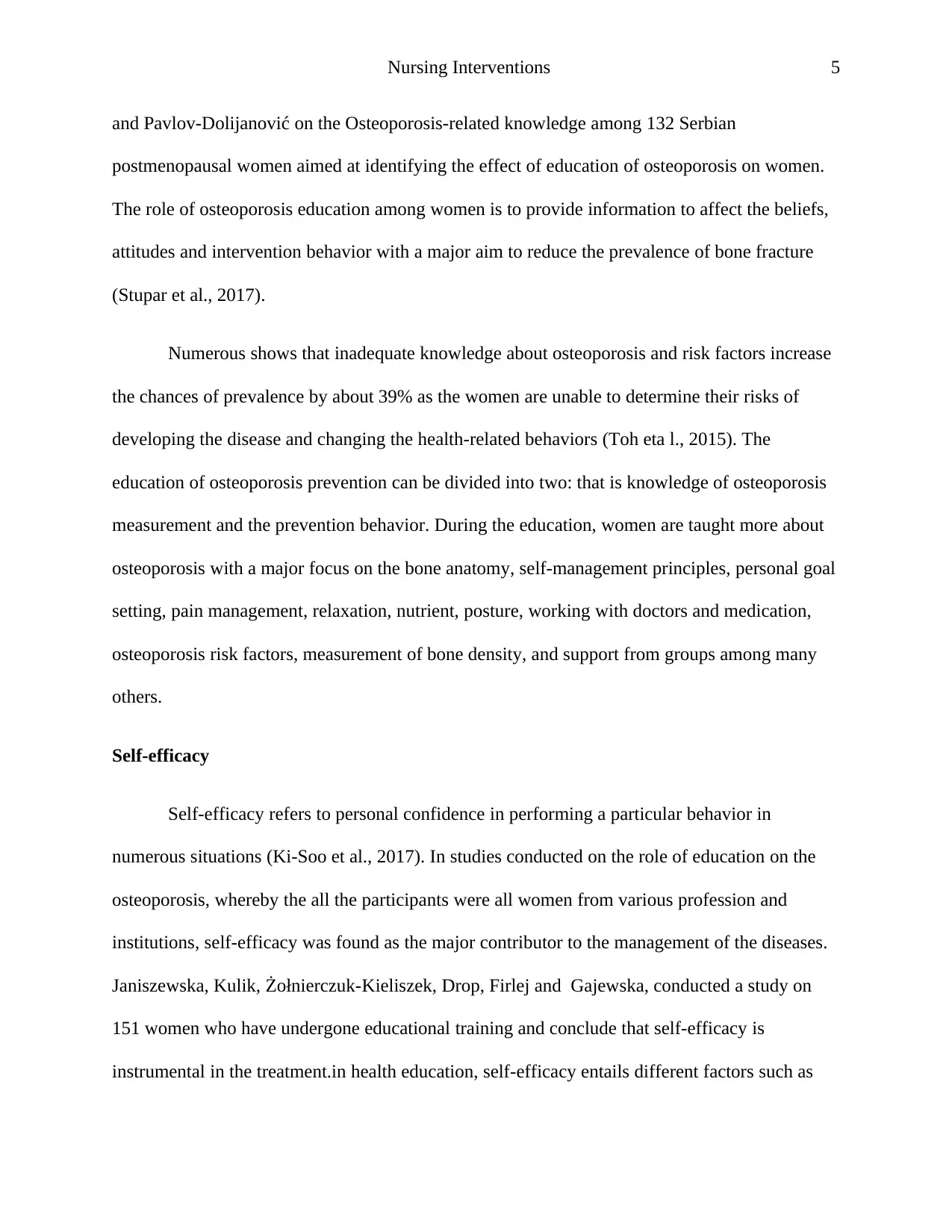
Nursing Interventions 5
and Pavlov-Dolijanović on the Osteoporosis-related knowledge among 132 Serbian
postmenopausal women aimed at identifying the effect of education of osteoporosis on women.
The role of osteoporosis education among women is to provide information to affect the beliefs,
attitudes and intervention behavior with a major aim to reduce the prevalence of bone fracture
(Stupar et al., 2017).
Numerous shows that inadequate knowledge about osteoporosis and risk factors increase
the chances of prevalence by about 39% as the women are unable to determine their risks of
developing the disease and changing the health-related behaviors (Toh eta l., 2015). The
education of osteoporosis prevention can be divided into two: that is knowledge of osteoporosis
measurement and the prevention behavior. During the education, women are taught more about
osteoporosis with a major focus on the bone anatomy, self-management principles, personal goal
setting, pain management, relaxation, nutrient, posture, working with doctors and medication,
osteoporosis risk factors, measurement of bone density, and support from groups among many
others.
Self-efficacy
Self-efficacy refers to personal confidence in performing a particular behavior in
numerous situations (Ki-Soo et al., 2017). In studies conducted on the role of education on the
osteoporosis, whereby the all the participants were all women from various profession and
institutions, self-efficacy was found as the major contributor to the management of the diseases.
Janiszewska, Kulik, Żołnierczuk-Kieliszek, Drop, Firlej and Gajewska, conducted a study on
151 women who have undergone educational training and conclude that self-efficacy is
instrumental in the treatment.in health education, self-efficacy entails different factors such as
and Pavlov-Dolijanović on the Osteoporosis-related knowledge among 132 Serbian
postmenopausal women aimed at identifying the effect of education of osteoporosis on women.
The role of osteoporosis education among women is to provide information to affect the beliefs,
attitudes and intervention behavior with a major aim to reduce the prevalence of bone fracture
(Stupar et al., 2017).
Numerous shows that inadequate knowledge about osteoporosis and risk factors increase
the chances of prevalence by about 39% as the women are unable to determine their risks of
developing the disease and changing the health-related behaviors (Toh eta l., 2015). The
education of osteoporosis prevention can be divided into two: that is knowledge of osteoporosis
measurement and the prevention behavior. During the education, women are taught more about
osteoporosis with a major focus on the bone anatomy, self-management principles, personal goal
setting, pain management, relaxation, nutrient, posture, working with doctors and medication,
osteoporosis risk factors, measurement of bone density, and support from groups among many
others.
Self-efficacy
Self-efficacy refers to personal confidence in performing a particular behavior in
numerous situations (Ki-Soo et al., 2017). In studies conducted on the role of education on the
osteoporosis, whereby the all the participants were all women from various profession and
institutions, self-efficacy was found as the major contributor to the management of the diseases.
Janiszewska, Kulik, Żołnierczuk-Kieliszek, Drop, Firlej and Gajewska, conducted a study on
151 women who have undergone educational training and conclude that self-efficacy is
instrumental in the treatment.in health education, self-efficacy entails different factors such as
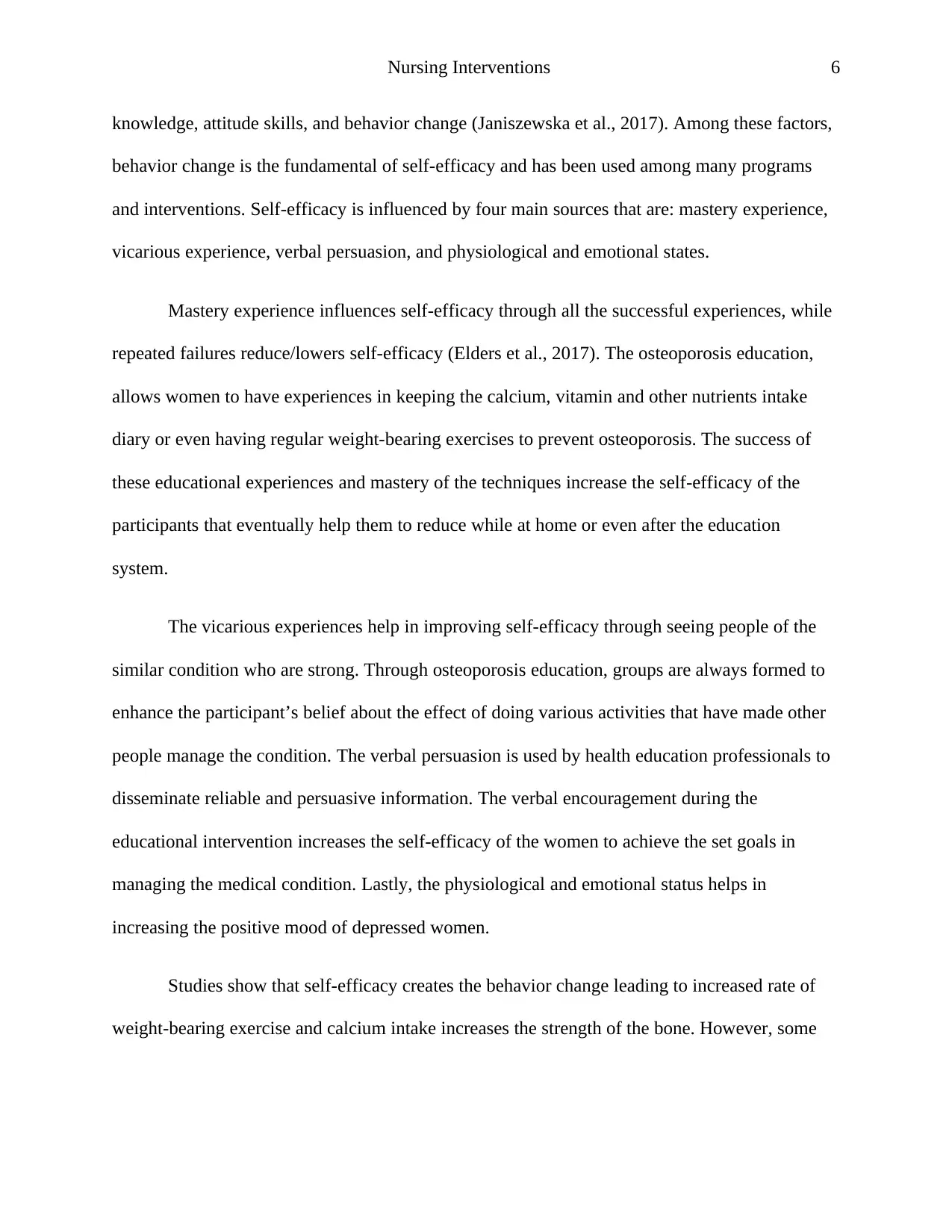
Nursing Interventions 6
knowledge, attitude skills, and behavior change (Janiszewska et al., 2017). Among these factors,
behavior change is the fundamental of self-efficacy and has been used among many programs
and interventions. Self-efficacy is influenced by four main sources that are: mastery experience,
vicarious experience, verbal persuasion, and physiological and emotional states.
Mastery experience influences self-efficacy through all the successful experiences, while
repeated failures reduce/lowers self-efficacy (Elders et al., 2017). The osteoporosis education,
allows women to have experiences in keeping the calcium, vitamin and other nutrients intake
diary or even having regular weight-bearing exercises to prevent osteoporosis. The success of
these educational experiences and mastery of the techniques increase the self-efficacy of the
participants that eventually help them to reduce while at home or even after the education
system.
The vicarious experiences help in improving self-efficacy through seeing people of the
similar condition who are strong. Through osteoporosis education, groups are always formed to
enhance the participant’s belief about the effect of doing various activities that have made other
people manage the condition. The verbal persuasion is used by health education professionals to
disseminate reliable and persuasive information. The verbal encouragement during the
educational intervention increases the self-efficacy of the women to achieve the set goals in
managing the medical condition. Lastly, the physiological and emotional status helps in
increasing the positive mood of depressed women.
Studies show that self-efficacy creates the behavior change leading to increased rate of
weight-bearing exercise and calcium intake increases the strength of the bone. However, some
knowledge, attitude skills, and behavior change (Janiszewska et al., 2017). Among these factors,
behavior change is the fundamental of self-efficacy and has been used among many programs
and interventions. Self-efficacy is influenced by four main sources that are: mastery experience,
vicarious experience, verbal persuasion, and physiological and emotional states.
Mastery experience influences self-efficacy through all the successful experiences, while
repeated failures reduce/lowers self-efficacy (Elders et al., 2017). The osteoporosis education,
allows women to have experiences in keeping the calcium, vitamin and other nutrients intake
diary or even having regular weight-bearing exercises to prevent osteoporosis. The success of
these educational experiences and mastery of the techniques increase the self-efficacy of the
participants that eventually help them to reduce while at home or even after the education
system.
The vicarious experiences help in improving self-efficacy through seeing people of the
similar condition who are strong. Through osteoporosis education, groups are always formed to
enhance the participant’s belief about the effect of doing various activities that have made other
people manage the condition. The verbal persuasion is used by health education professionals to
disseminate reliable and persuasive information. The verbal encouragement during the
educational intervention increases the self-efficacy of the women to achieve the set goals in
managing the medical condition. Lastly, the physiological and emotional status helps in
increasing the positive mood of depressed women.
Studies show that self-efficacy creates the behavior change leading to increased rate of
weight-bearing exercise and calcium intake increases the strength of the bone. However, some
⊘ This is a preview!⊘
Do you want full access?
Subscribe today to unlock all pages.

Trusted by 1+ million students worldwide
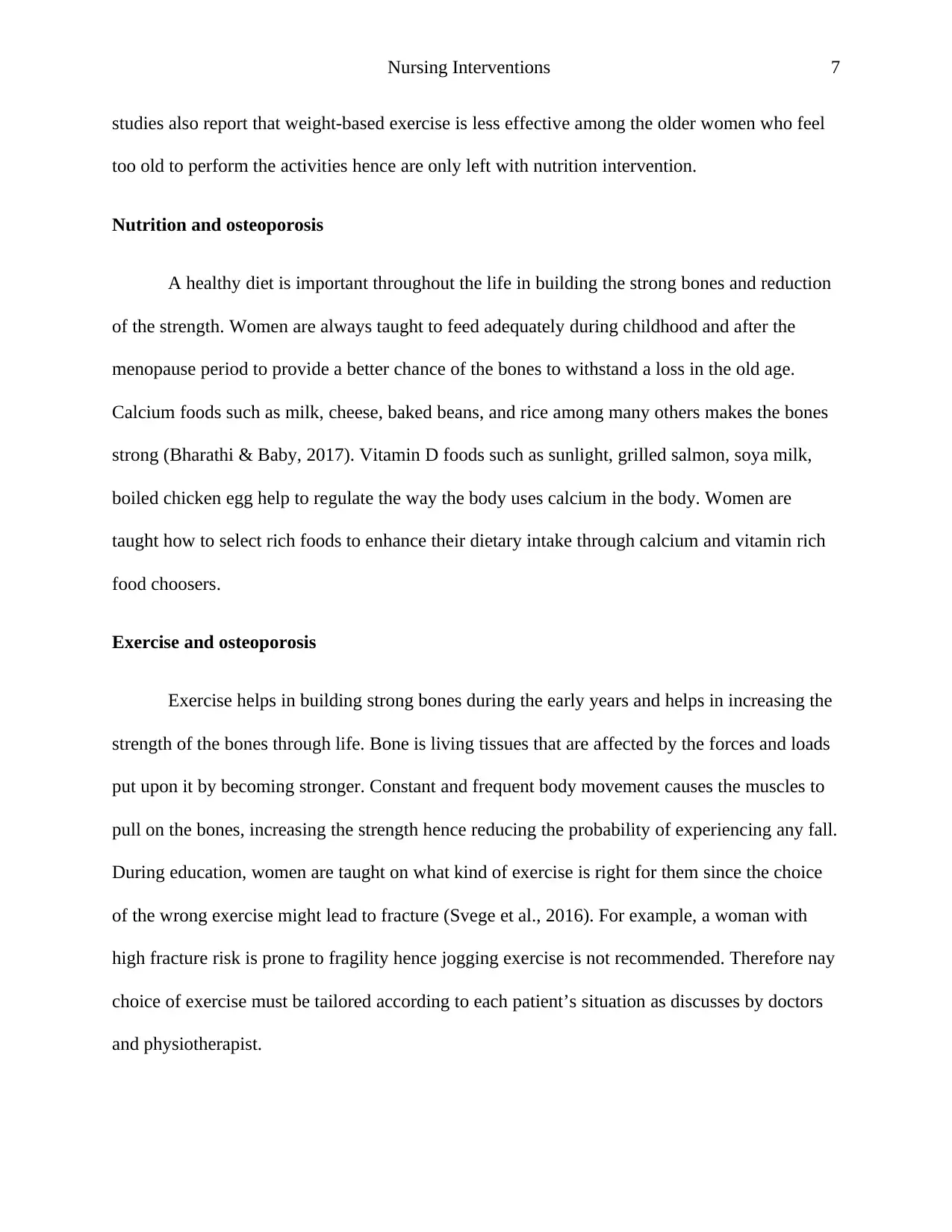
Nursing Interventions 7
studies also report that weight-based exercise is less effective among the older women who feel
too old to perform the activities hence are only left with nutrition intervention.
Nutrition and osteoporosis
A healthy diet is important throughout the life in building the strong bones and reduction
of the strength. Women are always taught to feed adequately during childhood and after the
menopause period to provide a better chance of the bones to withstand a loss in the old age.
Calcium foods such as milk, cheese, baked beans, and rice among many others makes the bones
strong (Bharathi & Baby, 2017). Vitamin D foods such as sunlight, grilled salmon, soya milk,
boiled chicken egg help to regulate the way the body uses calcium in the body. Women are
taught how to select rich foods to enhance their dietary intake through calcium and vitamin rich
food choosers.
Exercise and osteoporosis
Exercise helps in building strong bones during the early years and helps in increasing the
strength of the bones through life. Bone is living tissues that are affected by the forces and loads
put upon it by becoming stronger. Constant and frequent body movement causes the muscles to
pull on the bones, increasing the strength hence reducing the probability of experiencing any fall.
During education, women are taught on what kind of exercise is right for them since the choice
of the wrong exercise might lead to fracture (Svege et al., 2016). For example, a woman with
high fracture risk is prone to fragility hence jogging exercise is not recommended. Therefore nay
choice of exercise must be tailored according to each patient’s situation as discusses by doctors
and physiotherapist.
studies also report that weight-based exercise is less effective among the older women who feel
too old to perform the activities hence are only left with nutrition intervention.
Nutrition and osteoporosis
A healthy diet is important throughout the life in building the strong bones and reduction
of the strength. Women are always taught to feed adequately during childhood and after the
menopause period to provide a better chance of the bones to withstand a loss in the old age.
Calcium foods such as milk, cheese, baked beans, and rice among many others makes the bones
strong (Bharathi & Baby, 2017). Vitamin D foods such as sunlight, grilled salmon, soya milk,
boiled chicken egg help to regulate the way the body uses calcium in the body. Women are
taught how to select rich foods to enhance their dietary intake through calcium and vitamin rich
food choosers.
Exercise and osteoporosis
Exercise helps in building strong bones during the early years and helps in increasing the
strength of the bones through life. Bone is living tissues that are affected by the forces and loads
put upon it by becoming stronger. Constant and frequent body movement causes the muscles to
pull on the bones, increasing the strength hence reducing the probability of experiencing any fall.
During education, women are taught on what kind of exercise is right for them since the choice
of the wrong exercise might lead to fracture (Svege et al., 2016). For example, a woman with
high fracture risk is prone to fragility hence jogging exercise is not recommended. Therefore nay
choice of exercise must be tailored according to each patient’s situation as discusses by doctors
and physiotherapist.
Paraphrase This Document
Need a fresh take? Get an instant paraphrase of this document with our AI Paraphraser
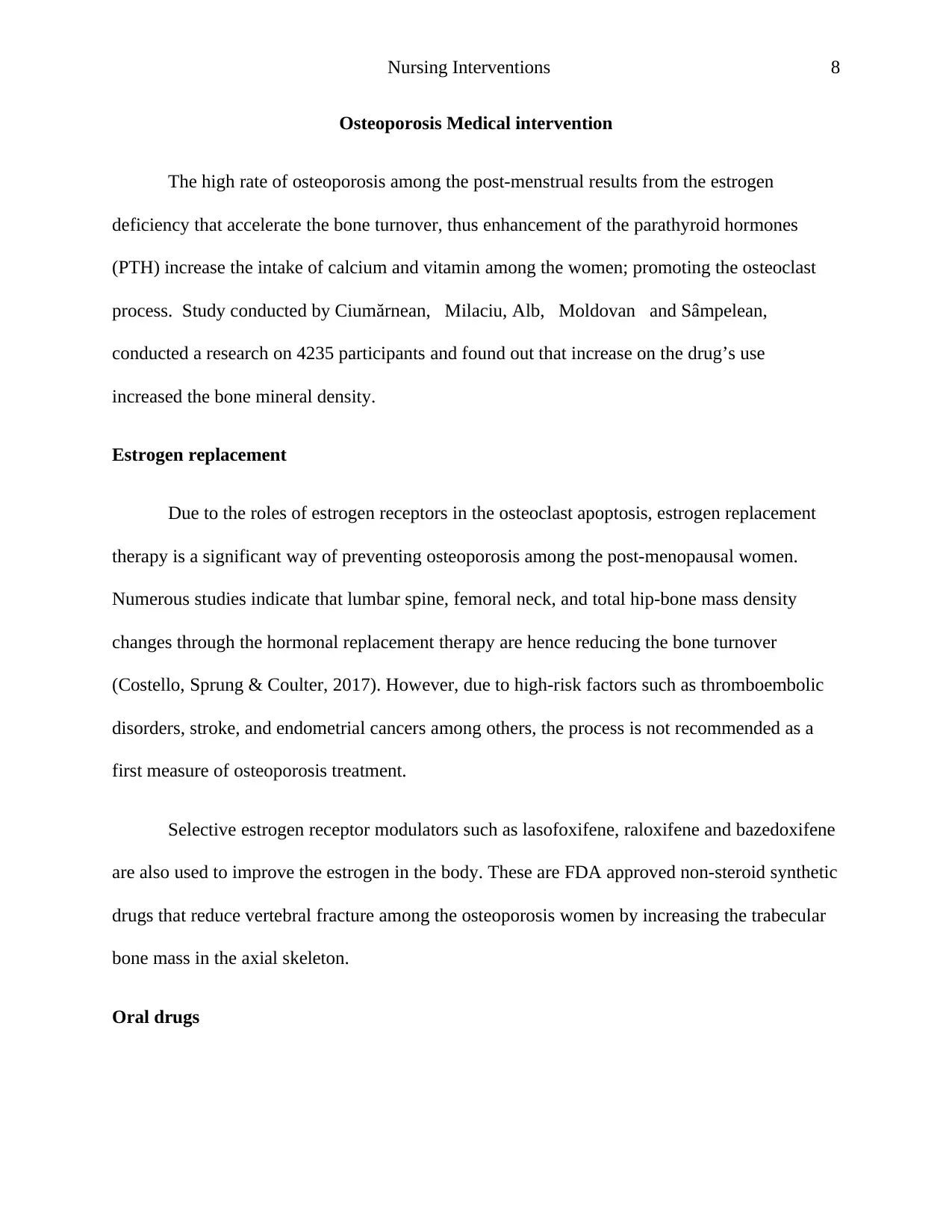
Nursing Interventions 8
Osteoporosis Medical intervention
The high rate of osteoporosis among the post-menstrual results from the estrogen
deficiency that accelerate the bone turnover, thus enhancement of the parathyroid hormones
(PTH) increase the intake of calcium and vitamin among the women; promoting the osteoclast
process. Study conducted by Ciumărnean, Milaciu, Alb, Moldovan and Sâmpelean,
conducted a research on 4235 participants and found out that increase on the drug’s use
increased the bone mineral density.
Estrogen replacement
Due to the roles of estrogen receptors in the osteoclast apoptosis, estrogen replacement
therapy is a significant way of preventing osteoporosis among the post-menopausal women.
Numerous studies indicate that lumbar spine, femoral neck, and total hip-bone mass density
changes through the hormonal replacement therapy are hence reducing the bone turnover
(Costello, Sprung & Coulter, 2017). However, due to high-risk factors such as thromboembolic
disorders, stroke, and endometrial cancers among others, the process is not recommended as a
first measure of osteoporosis treatment.
Selective estrogen receptor modulators such as lasofoxifene, raloxifene and bazedoxifene
are also used to improve the estrogen in the body. These are FDA approved non-steroid synthetic
drugs that reduce vertebral fracture among the osteoporosis women by increasing the trabecular
bone mass in the axial skeleton.
Oral drugs
Osteoporosis Medical intervention
The high rate of osteoporosis among the post-menstrual results from the estrogen
deficiency that accelerate the bone turnover, thus enhancement of the parathyroid hormones
(PTH) increase the intake of calcium and vitamin among the women; promoting the osteoclast
process. Study conducted by Ciumărnean, Milaciu, Alb, Moldovan and Sâmpelean,
conducted a research on 4235 participants and found out that increase on the drug’s use
increased the bone mineral density.
Estrogen replacement
Due to the roles of estrogen receptors in the osteoclast apoptosis, estrogen replacement
therapy is a significant way of preventing osteoporosis among the post-menopausal women.
Numerous studies indicate that lumbar spine, femoral neck, and total hip-bone mass density
changes through the hormonal replacement therapy are hence reducing the bone turnover
(Costello, Sprung & Coulter, 2017). However, due to high-risk factors such as thromboembolic
disorders, stroke, and endometrial cancers among others, the process is not recommended as a
first measure of osteoporosis treatment.
Selective estrogen receptor modulators such as lasofoxifene, raloxifene and bazedoxifene
are also used to improve the estrogen in the body. These are FDA approved non-steroid synthetic
drugs that reduce vertebral fracture among the osteoporosis women by increasing the trabecular
bone mass in the axial skeleton.
Oral drugs
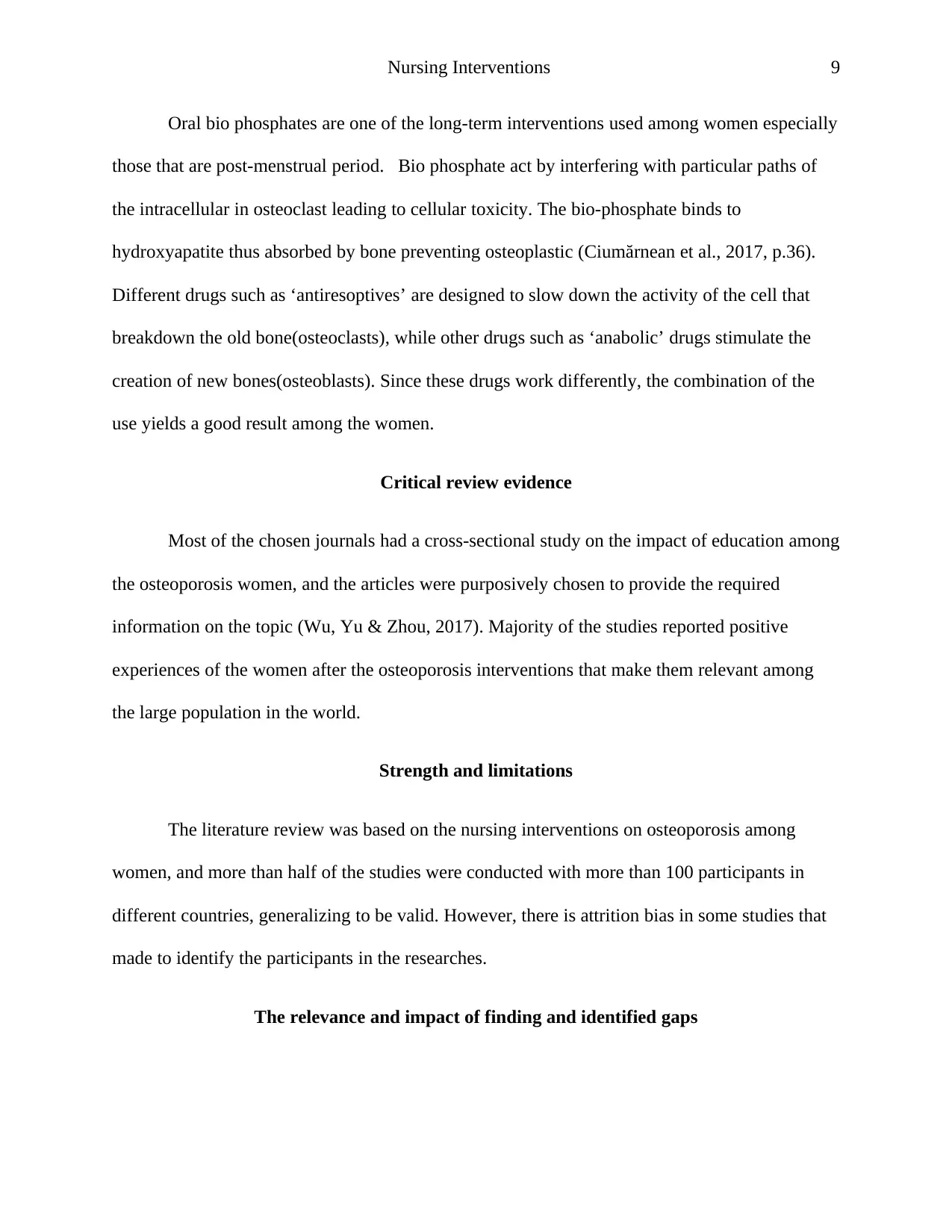
Nursing Interventions 9
Oral bio phosphates are one of the long-term interventions used among women especially
those that are post-menstrual period. Bio phosphate act by interfering with particular paths of
the intracellular in osteoclast leading to cellular toxicity. The bio-phosphate binds to
hydroxyapatite thus absorbed by bone preventing osteoplastic (Ciumărnean et al., 2017, p.36).
Different drugs such as ‘antiresoptives’ are designed to slow down the activity of the cell that
breakdown the old bone(osteoclasts), while other drugs such as ‘anabolic’ drugs stimulate the
creation of new bones(osteoblasts). Since these drugs work differently, the combination of the
use yields a good result among the women.
Critical review evidence
Most of the chosen journals had a cross-sectional study on the impact of education among
the osteoporosis women, and the articles were purposively chosen to provide the required
information on the topic (Wu, Yu & Zhou, 2017). Majority of the studies reported positive
experiences of the women after the osteoporosis interventions that make them relevant among
the large population in the world.
Strength and limitations
The literature review was based on the nursing interventions on osteoporosis among
women, and more than half of the studies were conducted with more than 100 participants in
different countries, generalizing to be valid. However, there is attrition bias in some studies that
made to identify the participants in the researches.
The relevance and impact of finding and identified gaps
Oral bio phosphates are one of the long-term interventions used among women especially
those that are post-menstrual period. Bio phosphate act by interfering with particular paths of
the intracellular in osteoclast leading to cellular toxicity. The bio-phosphate binds to
hydroxyapatite thus absorbed by bone preventing osteoplastic (Ciumărnean et al., 2017, p.36).
Different drugs such as ‘antiresoptives’ are designed to slow down the activity of the cell that
breakdown the old bone(osteoclasts), while other drugs such as ‘anabolic’ drugs stimulate the
creation of new bones(osteoblasts). Since these drugs work differently, the combination of the
use yields a good result among the women.
Critical review evidence
Most of the chosen journals had a cross-sectional study on the impact of education among
the osteoporosis women, and the articles were purposively chosen to provide the required
information on the topic (Wu, Yu & Zhou, 2017). Majority of the studies reported positive
experiences of the women after the osteoporosis interventions that make them relevant among
the large population in the world.
Strength and limitations
The literature review was based on the nursing interventions on osteoporosis among
women, and more than half of the studies were conducted with more than 100 participants in
different countries, generalizing to be valid. However, there is attrition bias in some studies that
made to identify the participants in the researches.
The relevance and impact of finding and identified gaps
⊘ This is a preview!⊘
Do you want full access?
Subscribe today to unlock all pages.

Trusted by 1+ million students worldwide
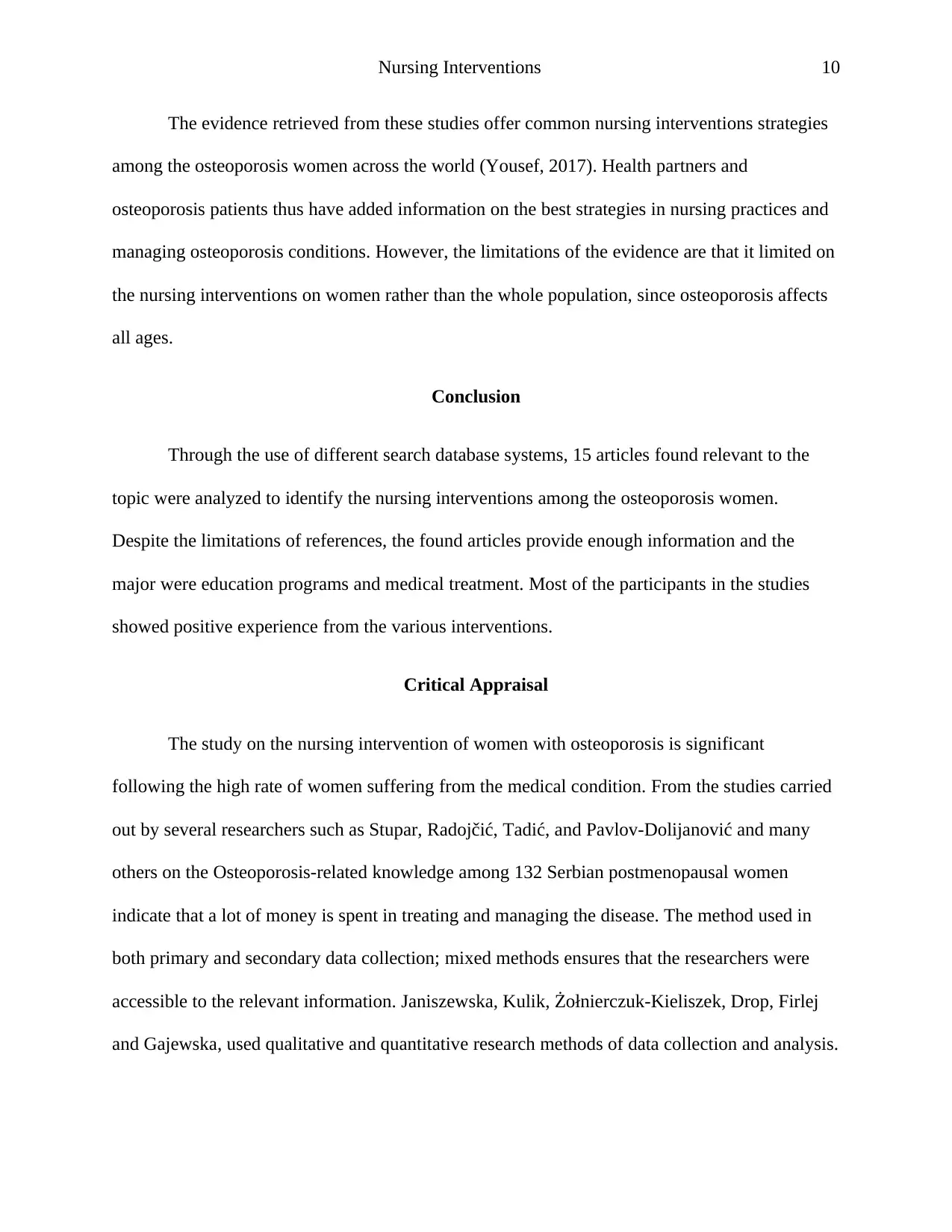
Nursing Interventions 10
The evidence retrieved from these studies offer common nursing interventions strategies
among the osteoporosis women across the world (Yousef, 2017). Health partners and
osteoporosis patients thus have added information on the best strategies in nursing practices and
managing osteoporosis conditions. However, the limitations of the evidence are that it limited on
the nursing interventions on women rather than the whole population, since osteoporosis affects
all ages.
Conclusion
Through the use of different search database systems, 15 articles found relevant to the
topic were analyzed to identify the nursing interventions among the osteoporosis women.
Despite the limitations of references, the found articles provide enough information and the
major were education programs and medical treatment. Most of the participants in the studies
showed positive experience from the various interventions.
Critical Appraisal
The study on the nursing intervention of women with osteoporosis is significant
following the high rate of women suffering from the medical condition. From the studies carried
out by several researchers such as Stupar, Radojčić, Tadić, and Pavlov-Dolijanović and many
others on the Osteoporosis-related knowledge among 132 Serbian postmenopausal women
indicate that a lot of money is spent in treating and managing the disease. The method used in
both primary and secondary data collection; mixed methods ensures that the researchers were
accessible to the relevant information. Janiszewska, Kulik, Żołnierczuk-Kieliszek, Drop, Firlej
and Gajewska, used qualitative and quantitative research methods of data collection and analysis.
The evidence retrieved from these studies offer common nursing interventions strategies
among the osteoporosis women across the world (Yousef, 2017). Health partners and
osteoporosis patients thus have added information on the best strategies in nursing practices and
managing osteoporosis conditions. However, the limitations of the evidence are that it limited on
the nursing interventions on women rather than the whole population, since osteoporosis affects
all ages.
Conclusion
Through the use of different search database systems, 15 articles found relevant to the
topic were analyzed to identify the nursing interventions among the osteoporosis women.
Despite the limitations of references, the found articles provide enough information and the
major were education programs and medical treatment. Most of the participants in the studies
showed positive experience from the various interventions.
Critical Appraisal
The study on the nursing intervention of women with osteoporosis is significant
following the high rate of women suffering from the medical condition. From the studies carried
out by several researchers such as Stupar, Radojčić, Tadić, and Pavlov-Dolijanović and many
others on the Osteoporosis-related knowledge among 132 Serbian postmenopausal women
indicate that a lot of money is spent in treating and managing the disease. The method used in
both primary and secondary data collection; mixed methods ensures that the researchers were
accessible to the relevant information. Janiszewska, Kulik, Żołnierczuk-Kieliszek, Drop, Firlej
and Gajewska, used qualitative and quantitative research methods of data collection and analysis.
Paraphrase This Document
Need a fresh take? Get an instant paraphrase of this document with our AI Paraphraser
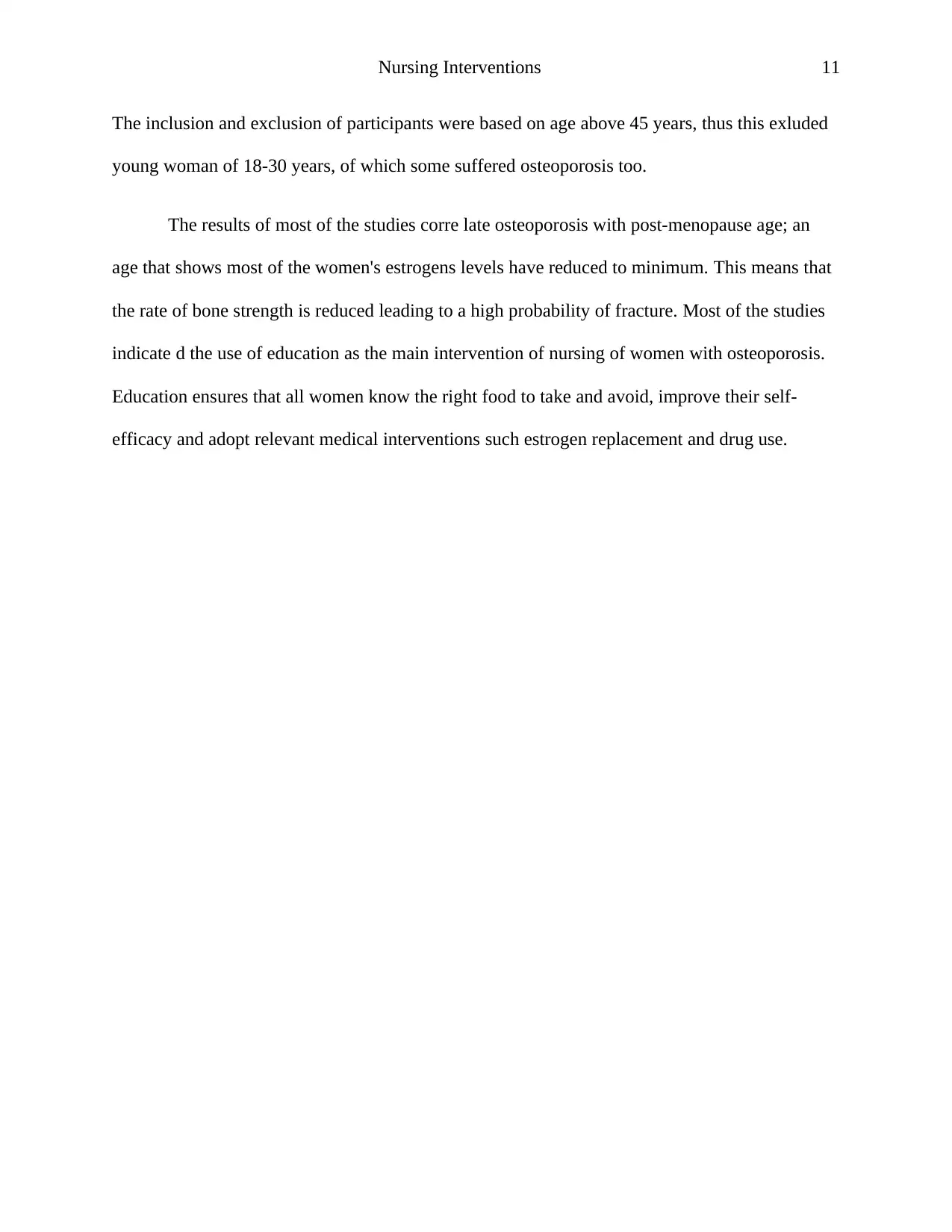
Nursing Interventions 11
The inclusion and exclusion of participants were based on age above 45 years, thus this exluded
young woman of 18-30 years, of which some suffered osteoporosis too.
The results of most of the studies corre late osteoporosis with post-menopause age; an
age that shows most of the women's estrogens levels have reduced to minimum. This means that
the rate of bone strength is reduced leading to a high probability of fracture. Most of the studies
indicate d the use of education as the main intervention of nursing of women with osteoporosis.
Education ensures that all women know the right food to take and avoid, improve their self-
efficacy and adopt relevant medical interventions such estrogen replacement and drug use.
The inclusion and exclusion of participants were based on age above 45 years, thus this exluded
young woman of 18-30 years, of which some suffered osteoporosis too.
The results of most of the studies corre late osteoporosis with post-menopause age; an
age that shows most of the women's estrogens levels have reduced to minimum. This means that
the rate of bone strength is reduced leading to a high probability of fracture. Most of the studies
indicate d the use of education as the main intervention of nursing of women with osteoporosis.
Education ensures that all women know the right food to take and avoid, improve their self-
efficacy and adopt relevant medical interventions such estrogen replacement and drug use.
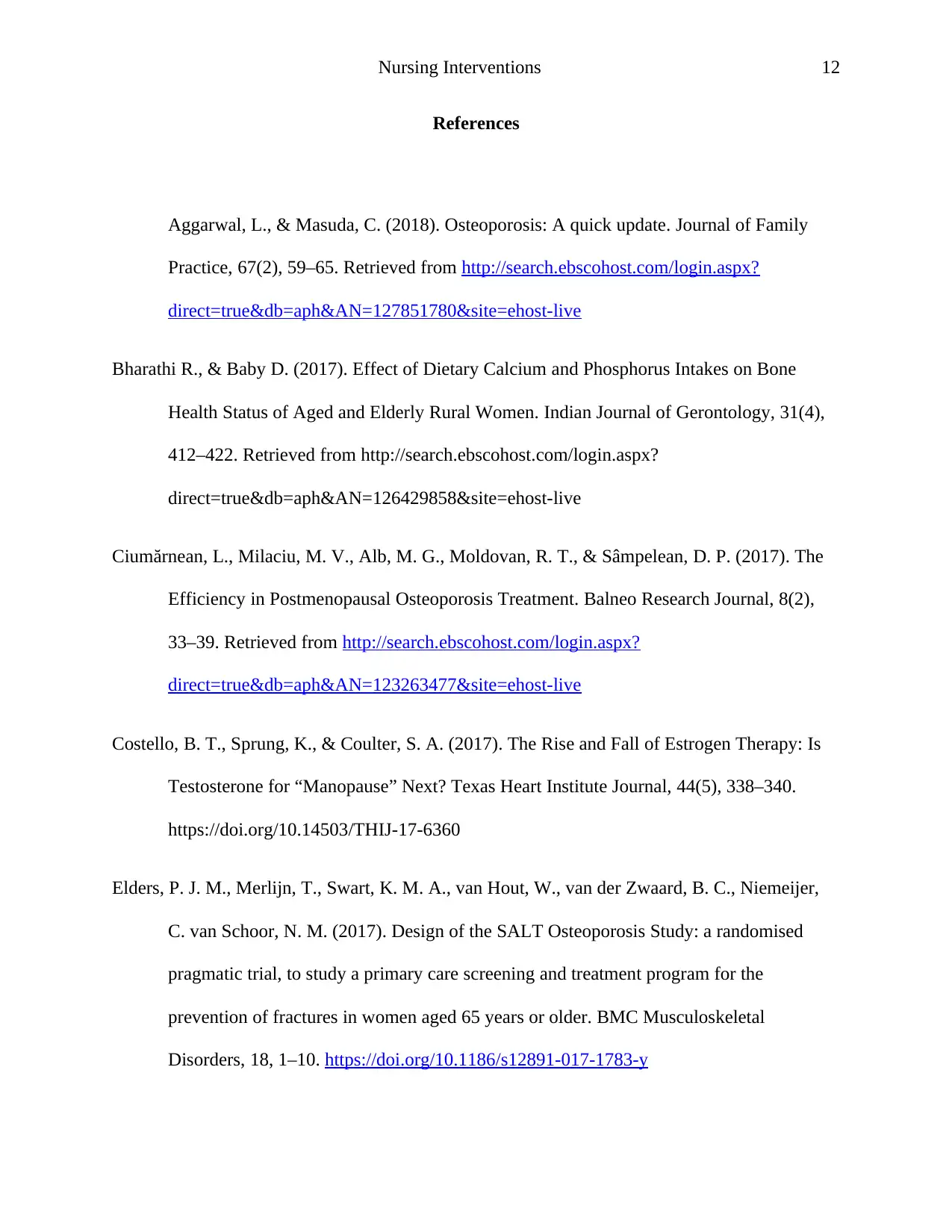
Nursing Interventions 12
References
Aggarwal, L., & Masuda, C. (2018). Osteoporosis: A quick update. Journal of Family
Practice, 67(2), 59–65. Retrieved from http://search.ebscohost.com/login.aspx?
direct=true&db=aph&AN=127851780&site=ehost-live
Bharathi R., & Baby D. (2017). Effect of Dietary Calcium and Phosphorus Intakes on Bone
Health Status of Aged and Elderly Rural Women. Indian Journal of Gerontology, 31(4),
412–422. Retrieved from http://search.ebscohost.com/login.aspx?
direct=true&db=aph&AN=126429858&site=ehost-live
Ciumărnean, L., Milaciu, M. V., Alb, M. G., Moldovan, R. T., & Sâmpelean, D. P. (2017). The
Efficiency in Postmenopausal Osteoporosis Treatment. Balneo Research Journal, 8(2),
33–39. Retrieved from http://search.ebscohost.com/login.aspx?
direct=true&db=aph&AN=123263477&site=ehost-live
Costello, B. T., Sprung, K., & Coulter, S. A. (2017). The Rise and Fall of Estrogen Therapy: Is
Testosterone for “Manopause” Next? Texas Heart Institute Journal, 44(5), 338–340.
https://doi.org/10.14503/THIJ-17-6360
Elders, P. J. M., Merlijn, T., Swart, K. M. A., van Hout, W., van der Zwaard, B. C., Niemeijer,
C. van Schoor, N. M. (2017). Design of the SALT Osteoporosis Study: a randomised
pragmatic trial, to study a primary care screening and treatment program for the
prevention of fractures in women aged 65 years or older. BMC Musculoskeletal
Disorders, 18, 1–10. https://doi.org/10.1186/s12891-017-1783-y
References
Aggarwal, L., & Masuda, C. (2018). Osteoporosis: A quick update. Journal of Family
Practice, 67(2), 59–65. Retrieved from http://search.ebscohost.com/login.aspx?
direct=true&db=aph&AN=127851780&site=ehost-live
Bharathi R., & Baby D. (2017). Effect of Dietary Calcium and Phosphorus Intakes on Bone
Health Status of Aged and Elderly Rural Women. Indian Journal of Gerontology, 31(4),
412–422. Retrieved from http://search.ebscohost.com/login.aspx?
direct=true&db=aph&AN=126429858&site=ehost-live
Ciumărnean, L., Milaciu, M. V., Alb, M. G., Moldovan, R. T., & Sâmpelean, D. P. (2017). The
Efficiency in Postmenopausal Osteoporosis Treatment. Balneo Research Journal, 8(2),
33–39. Retrieved from http://search.ebscohost.com/login.aspx?
direct=true&db=aph&AN=123263477&site=ehost-live
Costello, B. T., Sprung, K., & Coulter, S. A. (2017). The Rise and Fall of Estrogen Therapy: Is
Testosterone for “Manopause” Next? Texas Heart Institute Journal, 44(5), 338–340.
https://doi.org/10.14503/THIJ-17-6360
Elders, P. J. M., Merlijn, T., Swart, K. M. A., van Hout, W., van der Zwaard, B. C., Niemeijer,
C. van Schoor, N. M. (2017). Design of the SALT Osteoporosis Study: a randomised
pragmatic trial, to study a primary care screening and treatment program for the
prevention of fractures in women aged 65 years or older. BMC Musculoskeletal
Disorders, 18, 1–10. https://doi.org/10.1186/s12891-017-1783-y
⊘ This is a preview!⊘
Do you want full access?
Subscribe today to unlock all pages.

Trusted by 1+ million students worldwide
1 out of 36
Related Documents
Your All-in-One AI-Powered Toolkit for Academic Success.
+13062052269
info@desklib.com
Available 24*7 on WhatsApp / Email
![[object Object]](/_next/static/media/star-bottom.7253800d.svg)
Unlock your academic potential
Copyright © 2020–2025 A2Z Services. All Rights Reserved. Developed and managed by ZUCOL.





